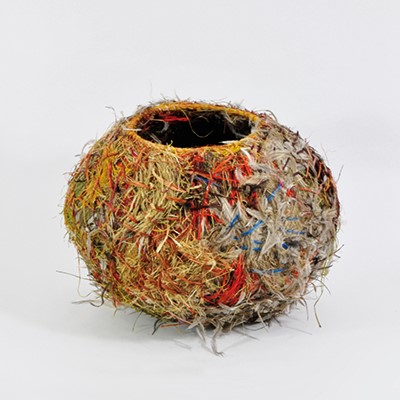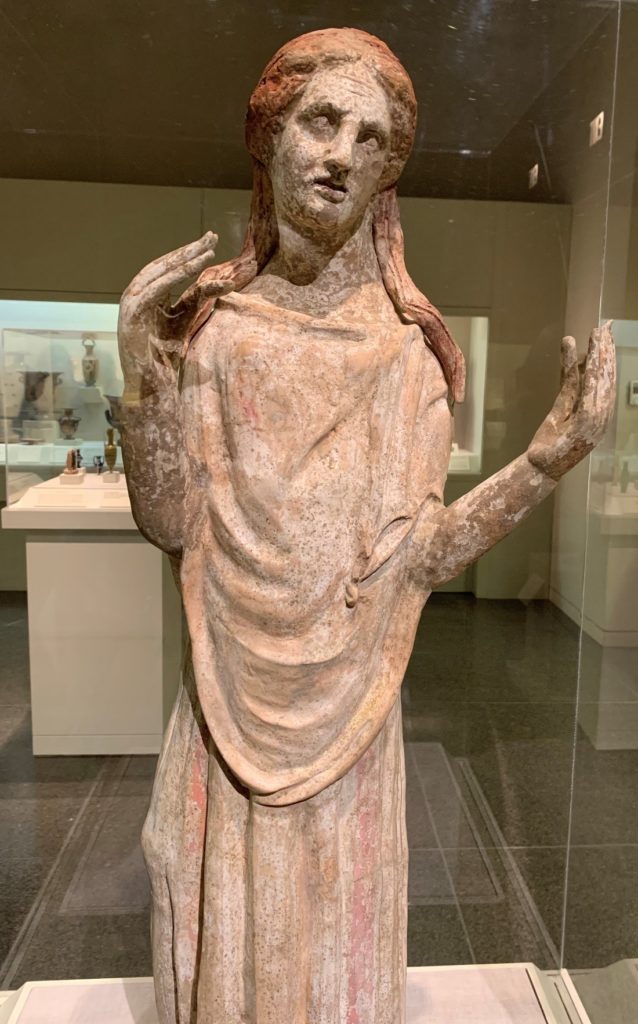Takeaway
Art captures both the ordinary and extraordinary moments of human lives throughout history, and offers insights into how to heal ourselves and one another.
This is the sixth in a series of monthly reflections by Dr. Flora Smyth Zahra, a dental educator from King’s College London (Twitter @HumanitiesinHPE; Instagram @clinicalhumanitiestoolbox) and Dr. Margaret “Meg” Chisolm (Twitter and Instagram @whole_patients). Drs. Smyth Zahra and Chisolm are participating in an Art Museum-based Health Professions Education (AMHPE) fellowship. Feeling inspired and uplifted by the program, they pledged to spend at least a half-day every month looking at art. This is the story of what they did in June.
Dr. Smyth Zahra
One of the great things about King’s College London acquiring Bush House, the old headquarters of the BBC World Service, is that we now have another gallery space. Throughout most of May and June, The Art of Healing: Australian Indigenous Bush Medicine, has been on view, courtesy of a partnership between Menzies Australia Institute at King’s, the Poche Centre for Indigenous Health, the Medical History Museum, University of Melbourne, and supported by our Culture team. Since committing to this series of reflections I have certainly spent much more time looking at artwork in gallery and museum spaces, but this small exhibition has perhaps been one of the most powerful; looking, reflecting, thinking. Finding out than in the 65,000 years that people have inhabited Australia, ‘Traditional Indigenous healing is a current practice informed by the past, and an intrinsic part of the life of Indigenous people in Australia. As such, healing forms part of “Indigenous Knowledge,” a term that refers to the world view of First Nations peoples.”
As a clinician and dentist, considering the embodied knowledge we have in our hands, I was fascinated to consider that this exhibition of contemporary art from many different Australian indigenous communities showed healing practices, aspects of this Indigenous knowledge based on the premise of Tjukurrpa (dreaming), when ancestral beings created the world as we know it.
I was particularly struck by the vibrant colours of many of the plants used in bush medicine and moved by the resilience of First peoples and their narratives, so much a part of the practice of the ngangkari (traditional healer). One example is a huge nest of raffia, emu feathers, and wool. Elder and Ngangkaṟi (traditional healer), Ilawanti Ungkutjuru Ken has created a basket based on observing birds’ nests to show the power of family and community for a person’s wellbeing. She says, “My basket is like a nest. This is the story about the wedge-tailed eagle. This is my big sister’s and my Tjukurpa. The wedge-tailed eagle soars a long way up in the air and can see everything. He can see all the food from up above, and all the living things are frightened of him. He cares for his little eaglets. He gives them food, proper bush tucker. We feel the same way about our family and care for them, too.”
Coincidentally, while the exhibition was running, the annual Excellence in Teaching Conference, #EiTC19, also took place. This year’s theme was ‘taking risks for teaching and learning.” The two events at first glance may not seem connected unless one starts to consider what is arguably the raison d’être of higher education – transformational learning. The education of clinicians follows a transformational model of professional development. A fundamental premise of Jack Mezirow’s theory (2009) is that learners need to be open to risk and to challenge their previously held assumptions. As faculty, it is our responsibility to facilitate and curate environments where transformative learning is most likely to occur. I argue that cross-disciplinary opportunities, away from the seminar room, clinics, and lecture theatres, like in a museum space, may help students accept their vulnerability and become more tolerant of both risk and ambiguity. Therefore, Dr. Jonathan Turner, the head of admissions from the faculty of dentistry, oral & craniofacial sciences, and myself, presented a workshop session in the Bush House art exhibition space entitled “Learner and faculty risk-taking for “belonging” and “becoming” on the path of personal development and professional identity formation.”
Linking a personal response tour of the art on display in the exhibition for faculty conference delegates across King’s to sociocultural theories of learning, we invited our colleagues to participate in this art-based approach to learning in the gallery, encouraging them via role modelling to risk employing teaching approaches they may previously not have considered in spaces that flatten hierarchies, encourage dialogue, and therefore promote the conditions most likely for the transformative learning necessary for personal and professional development.
Many participants felt that in a very short time frame they had undergone some sort of transformation. Many reported that they felt spiritually uplifted and refreshed from spending time together in that space connecting self and other through the medium of art.

Dr. Chisolm

The San Antonio Museum of Art. Photograph by Margaret Chisolm.
In May, I traveled to San Antonio, Texas, to participate in the annual meetings of the International Women’s and Children’s Health and Gender Group (InWomen’s Conference) and the College on Problems of Drug Dependence. With one day in-between these two meetings, I was able to visit the San Antonio Museum of Art, which sits along a long stretch of riverfront property in San Antonio on the campus of the former Lone Star Brewery. Entering this massive complex of repurposed pale brick buildings, I was unprepared for – and overwhelmed by – the sacred beauty that I found in the galleries.
The Museum’s collection includes art from Europe and North America, contemporary art, as well as ancient Mediterranean, Islamic, Asian, and Latin American art. In the cool, dark, quiet of the first galleries, I encountered objects from both ordinary and extraordinary moments of ancient Egyptian life (many placed in tombs for use in the afterlife): slate cosmetic palettes and glass ointment jars, alongside alabaster vases and stone statuettes of traditional Egyptian gods, and limestone reliefs from temples built for worshippers of the relatively short-lived cult of the sun disk. I saw gold coins, along with marble sarcophagi, and stone Canopic jars for the preservation of organs. But it was the fragment of a wooden coffin panel that reduced me to tears. Created in the mid-1st century BC-early 2nd century AD Egypt, this panel from the bottom of a child’s coffin is painted with the image of the goddess Isis, as a protection for the deceased’s safe journey to the afterlife.
As I walked through the other galleries, I found neo-Assyrian identification seals from 700 BC engraved with episodes from creation myths and marble Cycladic Island deity figures from 2700 BC. I saw an Athenian grave marker from 420 BC that showed a mother and father shaking one another’s hands, perhaps a gesture of reunion in the afterlife. And as I progressed through the Islamic, Asian, and Latin American art galleries, I continued to encounter evidence of the sacred. Whether a page from a Qur’an from 9th century Africa, a Bodhisattva from 17th century Japan, or a rare, preserved sand mandala made by a visiting delegation of Tibetan monks.
As I wandered through the cool and quiet galleries of the San Antonio Museum of Art, a respite from the heat of near-summer Texas, I came to realize that the art museum also provides another kind of refuge. An art museum is one of the few secular institutions that makes a space for the sacred in our contemporary society. Walking through the galleries that day, I was overwhelmed by how integrated spirituality has been in everyday life throughout human history. Spirituality has been a constant, sustaining thread in the lives of humans throughout the history of civilization. If the arts and humanities has anything to teach us about what it means to be human, then spirituality must clearly be part of that equation. If we as clinicians take care of our fellow humans during both ordinary and often extraordinary moments of our own and our patients’ lives, then spirituality must clearly be part of our medical education, as recognition of the sacred nature of these moments and our relationship is essential to the practice of clinical excellence.
Stay tuned to CLOSLER for our reflections on clinical excellence sparked by looking at art in July.

